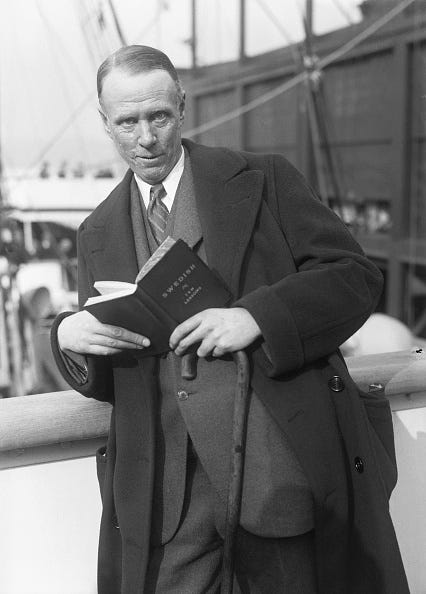“Tie the Strings to my Life, My Lord...” by Emily Dickinson. Public domain.
ORIGINAL TEXT AND AUDIO - 2017
It's the birthday of Sinclair Lewis, born in Sauk Centre, Minnesota (1885), author of Main Street (1920) and Babbitt (1922), and the first American to win the Nobel Prize in literature.
He left his hometown in Minnesota as soon as he could. He worked for newspapers and for publishing companies, wrote short stories for magazines, and wrote some potboiler novels and even a few serious novels, but none of his books did very well.
In 1920, H.L. Mencken and George Jean Nathan, who were editing the satirical magazine American Mercury, met up with 35-year-old "tall, skinny, paprika-headed" Sinclair Lewis, who was unknown in the writing world, at a mutual friend's apartment. Lewis walked up to Mencken and Nathan, put his arms around their shoulders and tightly around their necks, and began yelling at the top of his voice that he was the best writer in the country and that he'd just written the best book in the country, to be published in a week — and being critics, the two of them should duly take note of this. He went on like this at high volume for about half an hour, and when Mencken and Nathan finally escaped, they went to a pub to decompress and concluded that he was an idiot. But Mencken read the book anyway, and was bowled over by it.
The book was Main Street (1920), about a fictional small town in Minnesota called Gopher Prairie, a place inhabited by "a savorless people, gulping tasteless food, and sitting afterward, coatless and thoughtless, in rocking-chairs prickly with inane decorations, listening to mechanical music, saying mechanical things about the excellence of Ford automobiles, and viewing themselves as the greatest race in the world."
Main Street was a huge sensation. No one had ever written such a scathing satire of small-town American life. Within nine months, it sold about 200,000 copies, and within a few years, the book had sold 2 million copies and he'd become a millionaire. In 1922, he published Babbitt, which was also highly successful. He turned down the Pulitzer Prize that they tried to award him for his 1925 novel Arrowsmith, and when the Swedish Academy called to inform him he was being awarded the 1930 Nobel Prize in literature, he thought the phone call was a prank.
Though Sinclair Lewis left Minnesota as a teenager and spent most of his life traveling or living in Washington, D.C., 16 of his 22 novels involved Midwestern towns or Midwestern protagonists. He said he found creative inspiration while "sitting in Pullman smoking cars, in a Minnesota village, on a Vermont farm, in a hotel in Kansas City or Savannah, listening to the normal daily drone of what are to me the most fascinating and exotic people in the world — the Average Citizens of the United States."
It's the birthday of another writer from the prairie, Laura Ingalls Wilder, author of the wildly popular children's book Little House on the Prairie (1935) and several other books about growing up in the Midwest in the late 1800s. They're all part of the Little House series, which she began writing when she was in her 60s. Since her death, about a hundred different titles have appeared in the Little House series that she created. From her books have come also a television series on NBC (1974-84), a 26-episode animated Japanese cartoon series called "Laura, The Prairie Girl," a couple of made-for-TV movies, an ABC mini-series (2005), and a musical.
All of her books have remained in print continuously since the time they were first published, have been translated widely, and have sold millions of copies. Little House in the Big Woods begins, "Once upon a time, sixty years ago, a little girl lived in the Big Woods of Wisconsin, in a little gray house made of logs.
Be well, do good work, and keep in touch.®
PONTOON Audiobook (8 hours on CD)






Great selection today . ...and then there's Emily, I loved your reading of it.